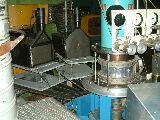|
HISTORY
STRUCTURE
ACTIVITIES
HEPD MEETINGS
USEFUL LINKS
SOCIAL LIFE
|
|
 |
 |
I n t e r m e d i a t e E n e r g y P h y s i c s :
Baryon spectroscopy with pion beams up to 2000 MeV.
 During last three decades, the experimental program "Baryon spectroscopy with pion beams up to 2000 MeV" is underway at
PNPI.
In the framework of this program a series of experiments have been carried out at the
PNPI pion channel in the energy range from 300 to 640 MeV.
The experiments included measurements of the differential cross sections (DCS), the polarization parameters P, A, R for
p- p
and p+ p
elastic scattering; in total, about 500 new experimental points were obtained during these
experiments.
( Figure 1 -
Main elements of the setup for measuring cross sections
of p- p
charge exchange scattering at the PNPI pion channel: on the right – a liquid hydrogen target,
on the
During last three decades, the experimental program "Baryon spectroscopy with pion beams up to 2000 MeV" is underway at
PNPI.
In the framework of this program a series of experiments have been carried out at the
PNPI pion channel in the energy range from 300 to 640 MeV.
The experiments included measurements of the differential cross sections (DCS), the polarization parameters P, A, R for
p- p
and p+ p
elastic scattering; in total, about 500 new experimental points were obtained during these
experiments.
( Figure 1 -
Main elements of the setup for measuring cross sections
of p- p
charge exchange scattering at the PNPI pion channel: on the right – a liquid hydrogen target,
on the
left – a p0 spectrometer).
A logical continuation of the mentioned above experiments is the study of
p- p
charge exchange scattering
p- p
®p0n,
which is in progress now at PNPI. After studying this process to the backward direction (performed by detecting the recoil neutron in coincidence with
one of photons from the decau
p0
® 2g),
a new step of investigations started - measurement of forward-angle DCS. For carrying out such experiment,
a new device - p0 spectrometer
- was designed and created at the Meson Physics Laboratory. The
p0 spectrometer consist of
two total absorption electromagnetic calorimeters each made of 24 CsI (Na) crystals. Owing to good energy
and spatial resolutions of calorimeters, the energies of both photons from the decay
p0
® 2g and the emission
angles of these photons can be measured with a good accuracy. On the base of these measurements, one can
reconstruct the energy of p0
meson produced in the reaction
p- p
® p0n
and the angle at which this meson was produced.
The experiment is underway now at the PNPI pion channel.
 Measurement of the spin rotation parameters A and R is a key experiment in the whole program of studying
p ± p
elastic scattering since only such measurement permits to remove discrete ambiguities arising in the
course of a phase shift analysis. A wide program of such experiments was performed at the pion
channel of the ITEP accelerator. Measurements were being performed by
PNPI scientists and engineers in
collaboration with physicists of Institute for Theoretical and Experimental Physics
Measurement of the spin rotation parameters A and R is a key experiment in the whole program of studying
p ± p
elastic scattering since only such measurement permits to remove discrete ambiguities arising in the
course of a phase shift analysis. A wide program of such experiments was performed at the pion
channel of the ITEP accelerator. Measurements were being performed by
PNPI scientists and engineers in
collaboration with physicists of Institute for Theoretical and Experimental Physics
( ITEP, Moscow).
( Figure.2 -
A fragment of setup for measuring the spin rotation parameters
in p ± p
elastic scattering at the ITEP pion channel: a polarized proton target (in the centre) and
tracking wire detectors (on the left and on the right).
The experiment has required a special type of polarized proton target with the polarization vector lying in the horizontal plane and a proton polarimeter for measuring the asymmetry of the secondary scattering of the recoil protons by nuclei of a substance (usually carbon) with the known analyzing power.
The polarized proton target was designed and manufactured at PNPI by physicists of the
Meson Physics
Laboratory (MPL) and the Laboratory of
Polarization Effects. The working material of the target was frozen down
to 0.6 K with a refrigerator using helium-3 evaporation, a required
magnetic field of 2.5 T was produced by a pair of superconducting
Helmholtz coils.
As to the proton polarimeter, two types were used
at different stages of the experiment. One was a multi-plate polarimeter made of optical spark chambers with graphite electrodes; a special television system was developed for filmless read-out in this case. Another type of polarimeter consists of one thick graphite block (36.5 g/cm2) with two arrays of spark chambers (in front and behind of this block) to detect the recoil proton before and after the secondary scattering.
The spin rotation parameters A, R for
p- p
and p+ p
elastic scattering were measured at ITEP at three energies of the incident pions: 875, 1300 and 1500 MeV. One of the most interesting results is the fact that experimentally measured values of the parameter A agree well with the predictions of the phase shift analysis VPI performed at Virginia Polytechnic Institute (VPI) and contradict to the analyses KH and CMU-LBL. Since all the characteristics of pN resonances presented in Listings of the Review of Particle Physics are obtained just on the base of the analyses KH and CMU-LBL, which seem to be not entirely correct in the light of our last experimental data, it is necessary to revise and specify these fundamental constants by means of performing a new phase shift analysis.
|
Other International Collaborations where HEPD PNPI is involved:
|
|
 |
 |



